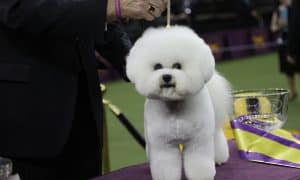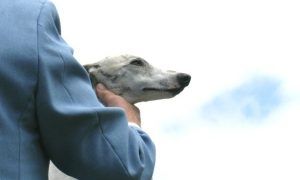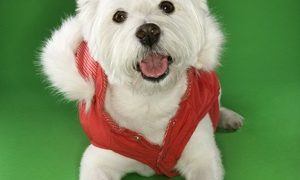“This post contains affiliate links, and I will be compensated if you make a purchase after clicking on my links.”
Are dog shows creating unhealthy breeds, just so they will “look good” and win “Best in Show”? That question causes a lot of controversy. Dog breeding has many purposes, and one of them is for show dogs. To help us understand the concept better, let’s have a quick review of the history between men and dogs. About 15,000 years ago, according to anthropological records, the first domesticated dogs are noticed. Since we wanted the dogs to fit in to our daily lifestyle, the breeding process changed from the natural to the artificial way. Can you imagine: we have been actually breeding dogs for thousands of years already!
To make the story short, dogs were the very first domesticated pet for humans. They have been our partners longer than any other animal in the world. They have also achieved many things as if they were humans, and sat alongside their masters throughout the years and centuries. In centuries past, selective breeding only took place when it was necessary to have dogs for the right use, such as herding, hunting, guarding, and others. Even though breeders of the past may not have known what “genetics” was, they apparently tried to breed dogs specifically for the needed tasks while at the same time maintaining the bloodline’s health. They instinctively understood that genetic issues are actually very important in a dog’s health.
Are Dog Shows Creating Unhealthy Breeds?
However, dog shows have emerged in the last couple of centuries, and show dogs have taken the limelight. And unfortunately, breed associations have changed over the years in setting up standards for the show dogs where their appearance is the all-important factor. And because of that, many breeders started to disregard the performance level and focus more on the dog’s overall appearance by breeding specific types simply to conform to the requirements and standards. Breeding solely for the sake of looks does not help a dog to stay healthy and live longer.
In fact, an educational article on the PBS website is quite harsh in stating a few of the many problems caused by this:
In the same way that inbreeding among human populations can increase the frequency of normally rare genes that cause diseases, the selective breeding that created the hundreds of modern dog breeds has put purebred dogs at risk for a large number of health problems, affecting both body and behavior.
Some conditions are directly related to the features breeders have sought to perpetuate among their dogs. As they deliberately manipulated the appearance of dogs to create or accentuate physical characteristics that were considered aesthetically pleasing, like the flat face of a bulldog or low-slung eyelids of a Bloodhound, breeders also created physical disabilities. The excessively wrinkled skin of the Chinese Shar-Pei causes frequent skin infection; Bulldogs and other flat-faced (or brachycephalic) breeds such as the Pekingese have breathing problems because of their set-back noses and shortened air passages; Bloodhounds suffer chronic eye irritation and infection.
The unnaturally large and small sizes of other breeds encourage different problems. For example, toy and miniature breeds often suffer from dislocating kneecaps and heart problems are more common among small dogs. Giant dogs such as Mastiffs, Saint Bernards, and Great Danes are nearly too big for their own good. Researchers have found a striking correlation between a dog’s large size and a frequency of orthopedic problems like hip dysplasia.
And here is a fact we probably already know: many establishments and places ban pit bulls and bulldogs, simply because they are often the ones publicized in dog attacks, which is not generally true, as not all of those types of breeds are vicious. In fact, they are some of the oldest breeds in history, with dog skulls found in some ruins in Pompeii. They should not be put into the publicity fire – they just need to be understood. After all, when trained properly, they can be even friendlier than the good-looking dogs out there.
This is the sad fact in dog breeding history: many breeding associations have exaggerated their requirements for show dogs, in which a dog’s health and longevity is sometimes apparently not even remotely given a second thought. For example, some breeds have external features that keep them from being normal dogs. There are some parts of dog that are very vital, such as its nose, which is responsible for a dog’s thermoregulation or adjusting their body temperature. While humans can sweat, dogs cannot.
Not even daily trips to local vets can help prolong your dog’s life once it has bad genetics. Perhaps dog owners and breed show associations need to think over their breeding methods and standards. Maybe it’s time to help the dogs live a longer life by focusing on its health rather than its appearance when selective breeding. In this way, we would really show them our proper concern.
I have always been somewhat uncomfortable with dog shows, because to me they were artificial. For instance, why are there 6 “new” breeds accepted recently? Have they had a natural bloodline down through the centuries? Have they been so inbred just for the sake of creating “new” show dogs, that they will have poor health and short lifespans just to satisfy somebody’s ego and vanity needs? Now that I know that dogs’ supposedly loving caretakers are actually creating and perpetuating unhealthy dog breeds, I can no longer in good conscience watch them.
So, what is your answer to the question: are dog shows creating unhealthy breeds? Share your thoughts below.



















moncler bodywarmer
Sep 23, 2014 at 11:39 pm
brothersteve.net/bulgarie/sale-jackets-for-women.html sale jackets for women
Sally Stephens
Aug 8, 2014 at 6:47 pm
Yes, I do feel that many breeders have contributed to the growing health problems we are seeing more frequently in our beloved pets. People, please stop thinking these unhealthy dogs are cute (Chows, pugs, yorkies, bulldogs, Dotties etc). When their faces are becoming more & more mashed were the dog can’t breath normally & their legs are so bowed out that they have many leg, hip & joint problems. Their backs are breed to be longer & longer. Health before looks!!! There are legitimate breeders out there. However, unfortunately, because many of these hybrid designer breeds drawn in quite a bit of side $$$, there are vultures out there backyard & inbreeding. Many “dog pros” do inbreeding practices too, just as they do with horses. Don’t take my experiences & word for it, look it up/research facts in your local library.
cyberhowl
Jan 2, 2014 at 5:18 pm
I feel this entire article is extremely biased in every way possible.
Yes, there ARE breeds that have been bred away from what they were originally intended for – I’ll not deny that. The Akita is a case in point – per the Japanese, the American Akita is larger, “blockier”, and is incorrectly colored per the Japanese standard. I’ve heard that the Japanese would prefer the Americans not call “our” version “Akita” any longer, as the American version is far removed from the Japanese Standard (Japan being the country of origin).
I have raised and shown Shiba Inus for 15+ years – another Japanese breed. As a National Club member, we have tried to stay close to the Japanese Standard, to the point of bringing Japanese judges over twice a year to evaluate our stock and breeding programs. The breed itself was almost wiped out during WW2, but was brought back from the brink by selective breeding / inbreeding. Yes, we have health problems because of that, but we strive to overcome those problems via selective breeding programs and DNA testing. We have also tried to adhere to the JAPANESE standard set many, many years ago.
There is a HUGE difference between RESPONSIBLE breeders and your typical back-yard breeder (BYB) or puppymill breeders. A responsible breeder knows what health issues lie within their breed, and will test their breeding stock for those issues BEFORE even considering breeding the dog in question. As I type, there are more and more DNA tests that are becoming available to help identify hidden genetic factors that would be detrimental to the breed, and REPUTABLE breeders are taking advantage of the DNA testing, as it pertains to their specific breed. At the very MINIMUM, a REPUTABLE breeder would / should be testing for hips, knees, and eyes – many ailments which aren’t seen with the naked eye… how many BYBs or mills do that? How many REPUTABLE breeders test their dogs’ eyes for hereditary problems? At least half (especially since they can have this done at a dog show). How many BYB’s test THEIR dogs? 0 So, you may find (as an example)10 out of a 100 “show dogs” with eye problems, but is that a fair comparison, when there is no database from pups produced at a mill, or sold as “pets”?
I also have to question the fact of how many BYB’s even KNOW what makes a correct representation of the breed they are producing? Working with Shiba Rescue, I have seen example after example of poorly-bred Shibas, both from local BYB’s and Mills in the mid-west. HUGE ears, round eyes, even pinto-coloring. But, technically, they are Shibas. How are they equated into the original article here?
There is also the fact that the AKC is encouraging specific activities to actually see if these various breeds can still do what they were bred to do. There are “Earthdog Trials” at a few shows each year. Earthdog trials are a event where a caged rat (so the rat will not be harmed) is put at the end of an artificial underground tunnel, and the dog is timed on how quickly the dog picks up the scent, goes to ground (goes into the tunnel), and barks when it reaches the prey. This type of trial is mainly intended for the terrier type of dog, as that is what they were BRED TO DO. They have just started “Barn Hunts”, very similar to the Earthdog Trials, but intended for larger hunting dogs that cannot go underground. There have always been the field hunting trials for your Retrievers and Setters. Whether a breeder wants to participate in this type of event is strictly up to them, but it is NOT uncommon for a pure-bred dog to have TWO sets of titles – the Conformation titles (“Dog show”) and the Working titles (“field events).
As I stated at the beginning of my post, not ALL breed clubs follow by the same set of rules, but I believe that even those that have “gone astray” are beginning to realize that looks are only a part of the overall dog, and are paying closer attention to health and function. Do pure-bred dogs have more health issues? AS compared to what, when BYB’s or pet owners don’t necessarily test for things that breeders do. I, myself, have had 2 pups with eye problems – but would not have known about either, if I had not had each of them tested.
It’s unfortunate that people who write articles like the above like to hang all the ills of the dogworld on the backs of breeders without distinguishing a good breeder from a bad breeder, or even from the puppymills. Good breeders DON’T crossbreed one breed with another to produce “designer dogs” (which are very expensive crossbreed mixes/mutts – unknown genetics?), good breeders do have their stock tested for health issues, etc., etc… Thank DOG for GOOD breeders!
gexcall.unex.es
Jun 18, 2013 at 9:13 am
At this time I am going away to do my breakfast,
after having my breakfast coming again to read further news.
chantal
Apr 4, 2013 at 2:38 am
Its wrong to say that only puppy-mills are responsible for breeds like the bulldog with there respiratory disses . like the spaniels with syringomyelia, the are the fault of breed standards look at the germane shepherd , there low backhand , its not seen in the wild, its not natural.
Dianne Zeller
Jul 19, 2012 at 3:17 pm
I feel that this article is quite biased on the negativity of Dog Shows and ‘responsible breeders’ who enter their dogs into the DS arena. Further, there was no mention of ‘responsible breeders’ who use the Dog Show arena to propagate and reflect on the lack of ‘inbreeding’. Another, lack in your article was no mention of the puppy mills and backyard breeding industries.
In the 1960’s and 1970’s the Doberman Pinscher had the same reputation that Bull dogs, and Pit Bulls have now. The American Doberman Pinscher in conjunction with AKC (of which my mother belonged to as a breeder.) decided to change the temperament and bad press the breed had. They began to breed for temperament as well as other features that were attributed to the ‘viscious’ traits associated to the breed. They were very successful and now the breed is known for its loyalty to their family (as apposed to an individual) and of course their temperament (which is known as even tempered animals with the ability to be well trained, and still be effective as a guard dog). Responsible breeders in the club and members of the AKC did this by breeding mellow dogs to other mellow dogs but not to family members. If I remember properly the (selective breeding) was done with the project in about 10 years as ’selective breeding’ changes have to thru generations of the animal to make a change into a standard.
In my opinion ‘puppy mills’ are the ones to blame for ‘inbreeding’ and the lack of ’selective breeding’ as they will keep a brood bitch pregnant to the same stud for as long as she can produce puppies. There goal is to make money off of the dogs and will do so until they can in any way possible. Another factor to be considered for this article should have been ‘backyard breeders’ who are not registered members to AKC.
Both associations worked together to quell the negativity and were successful! Thus, I feel that your article was negative and could have been more positive in their point of view by researching ‘responsible breeders’ in America and by exposing the lack of caring for breed standards and caring of the puppy mill industry!